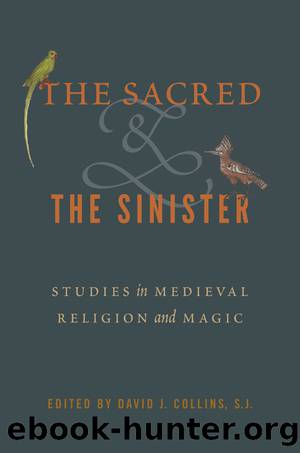The Sacred and the Sinister by David J. Collins S.J

Author:David J. Collins, S.J.
Language: eng
Format: epub
ISBN: 9780271082400
Publisher: The Pennsylvania State University Press
Real and Imagined Magic
The critique could be raised, at this point, that much of what I have described so far pertains not to how actual magical practices were shaped by or reflected broader currents of medieval history, but rather how clerical authoritiesâ perceptions of such practices were reshaped over time. This is true, and it is an inevitable problem that scholars of medieval magic must confront. Most of the surviving sources that discuss medieval magical practices are hostile ones: condemnatory accounts by theologians, jurists, moralists, and preachers, along with some scattered trials records, mainly from the late medieval period.40 The descriptions of magic that these sources present, from the supposedly pagan-inflected rites of early medieval discourse to the horrific imaginaire of the witchesâ sabbath that emerged only in the fifteenth century, can be extremely formulaic. Of course, the history of medieval heresy raises the same problems, and in some ways so, too, does the history of religious orders. Certainly the hagiographies of their leading figures, through which the orders often constructed much of their own identities, are replete with stock formulas of sanctity. Some orders may even have recrafted their own early history in light of later developments and to justify later practices and organizational structures.41
Grundmann confronted this problem when he engaged with the history of heresy, and he certainly knew that clerical condemnations of heretical depravities could not be taken at face value. More deeply, he recognized a formulaic âTypus des Ketzersâ that informed clerical accounts and even clerical perceptions of supposed heretical groups.42 Although he never discussed a âTypus des Magiers,â he recognized the applicability of his insights about heretics to later stereotypes concerning supposedly diabolical witches.43 Moreover, in Religious Movements Grundmann suggested that what ecclesiastical authorities constructed as the late medieval heresy of the Free Spirit never comprised a coherent sect, as Robert Lerner later conclusively proved.44 Grundmannâs skepticism did not run so deep with other heretical movements, such as the Cathars, but some scholars now suggest that even the great high medieval heresies existed more as figments of clerical imagination than in reality.45 Other scholars continue to see more substance to heresyâs existence, and I do not intend to venture too deeply into these debates here.46 I merely want to point out that, as the lines between ârealâ and âimaginedâ heresies become increasingly fluid, the reasons to bracket off the imagined sect of witches categorically from other heretical sects encompassed in Grundmannâs religious movement become less substantial as well.
In the history of witchcraft, one of Richard Kieckheferâs early contributions was to show that elements of diabolism in witchcraft accusations emerged only at the very end of the medieval period, mainly in the fifteenth century, and then to demonstrate how those elements were, for the most part, grafted by clerical authorities onto more basic accusations of simple maleficium in the course of early trials.47 His conclusions in this regard have been generally confirmed by subsequent studies of late medieval witch trials.48 Although witch trials typically were driven
Download
This site does not store any files on its server. We only index and link to content provided by other sites. Please contact the content providers to delete copyright contents if any and email us, we'll remove relevant links or contents immediately.
| Buddhism | Christianity |
| Ethnic & Tribal | General |
| Hinduism | Islam |
| Judaism | New Age, Mythology & Occult |
| Religion, Politics & State |
Cecilia; Or, Memoirs of an Heiress — Volume 1 by Fanny Burney(31339)
Cecilia; Or, Memoirs of an Heiress — Volume 3 by Fanny Burney(30935)
Cecilia; Or, Memoirs of an Heiress — Volume 2 by Fanny Burney(30891)
The Secret History by Donna Tartt(16635)
Sapiens: A Brief History of Humankind by Yuval Noah Harari(13059)
Leonardo da Vinci by Walter Isaacson(11907)
The Radium Girls by Kate Moore(10910)
Sapiens by Yuval Noah Harari(4540)
The Wind in My Hair by Masih Alinejad(4426)
How Democracies Die by Steven Levitsky & Daniel Ziblatt(4401)
Homo Deus: A Brief History of Tomorrow by Yuval Noah Harari(4282)
Endurance: Shackleton's Incredible Voyage by Alfred Lansing(3845)
The Silk Roads by Peter Frankopan(3764)
Man's Search for Meaning by Viktor Frankl(3637)
Millionaire: The Philanderer, Gambler, and Duelist Who Invented Modern Finance by Janet Gleeson(3572)
The Rape of Nanking by Iris Chang(3518)
Hitler in Los Angeles by Steven J. Ross(3440)
The Motorcycle Diaries by Ernesto Che Guevara(3338)
Joan of Arc by Mary Gordon(3260)
